| Listing 1 - 10 of 46 | << page >> |
Sort by
|
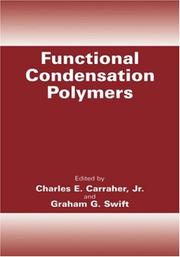
ISBN: 1280200510 9786610200511 159124692X 0306475634 0306472457 Year: 2002 Publisher: New York : Kluwer Academic Publishers,
Abstract | Keywords | Export | Availability | Bookmark
 Loading...
Loading...Choose an application
- Reference Manager
- EndNote
- RefWorks (Direct export to RefWorks)
Although in nature the vast majority of polymers are condensation polymers, much publicity has been focused on functionalized vinyl polymers. Functional Condensation Polymers fulfills the need to explore these polymers which form an increasingly important and diverse foundation in the search for new materials in the twentyfirst century. Some of the advantages condensation polymers hold over vinyl polymers include offering different kinds of binding sites, their ability to be made biodegradable, and their different reactivities with various reagents under diverse reaction conditions. They also offer better tailoring of end-products, different tendencies (such as fiber formation), and different physical and chemical properties. Some of the main areas emphasized include dendrimers, control release of drugs, nanostructure materials, controlled biomedical recognition, and controllable electrolyte and electrical properties.
Polycondensation. --- Condensation products (Chemistry) --- Polymers. --- Surfaces (Physics). --- Polymer Sciences. --- Characterization and Evaluation of Materials. --- Polymers . --- Materials science. --- Material science --- Physical sciences --- Polymere --- Polymeride --- Polymers and polymerization --- Macromolecules
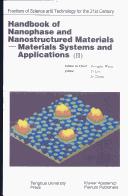
ISBN: 0306483718 038723814X 030647249X 0387335528 Year: 2002 Publisher: New York, NY : Springer US : Imprint: Springer,
Abstract | Keywords | Export | Availability | Bookmark
 Loading...
Loading...Choose an application
- Reference Manager
- EndNote
- RefWorks (Direct export to RefWorks)
These books, with of a total of 40 chapters, are a comprehensive and complete introductory text on the synthesis, characterization, and applications of nanomaterials. They are aimed at graduate students and researchers whose background is chemistry, physics, materials science, chemical engineering, electrical engineering, and biomedical science. The first part emphasizes the chemical and physical approaches used for synthesis of nanomaterials. The second part emphasizes the techniques used for characterizing the structure and properties of nanomaterials, aiming at describing the physical mechanism, data interpretation, and detailed applications of the techniques. The final part focuses on systems of different nanostructural materials with novel properties and applications.
Materials science. --- Physical chemistry. --- Optical materials. --- Electronic materials. --- Materials Science. --- Characterization and Evaluation of Materials. --- Optical and Electronic Materials. --- Physical Chemistry. --- Surfaces (Physics). --- Chemistry, Physical organic. --- Chemistry, Physical organic --- Chemistry, Organic --- Chemistry, Physical and theoretical --- Optics --- Materials --- Physics --- Surface chemistry --- Surfaces (Technology) --- Nanostructured materials --- Chemistry, Theoretical --- Physical chemistry --- Theoretical chemistry --- Chemistry --- Electronic materials --- Material science --- Physical sciences --- Characterization and Analytical Technique. --- Optical Materials. --- Analysis.
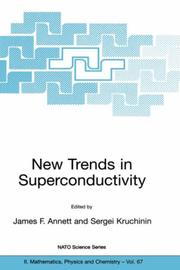
ISBN: 9401005443 1402007051 1402007043 Year: 2002 Volume: v. 67 Publisher: Dordrecht ; Boston ; London Brussels Kluwer Academic Publishers NATO Scientific Affairs Division
Abstract | Keywords | Export | Availability | Bookmark
 Loading...
Loading...Choose an application
- Reference Manager
- EndNote
- RefWorks (Direct export to RefWorks)
Superconductivity --- Superconductors --- Physics --- Physical Sciences & Mathematics --- Electricity & Magnetism --- Atomic Physics --- Supraconductivité --- Supraconducteurs --- Congresses. --- Congrès --- Condensed matter. --- Magnetism. --- Magnetic materials. --- Materials science. --- Condensed Matter Physics. --- Magnetism, Magnetic Materials. --- Characterization and Evaluation of Materials. --- Material science --- Physical sciences --- Materials --- Mathematical physics --- Electricity --- Magnetics --- Condensed materials --- Condensed media --- Condensed phase --- Materials, Condensed --- Media, Condensed --- Phase, Condensed --- Liquids --- Matter --- Solids
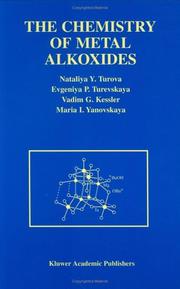
ISBN: 9780792375210 0792375211 9780306476570 9786610201419 128020141X 0306476576 Year: 2002 Publisher: Boston Kluwer Academic Publishers
Abstract | Keywords | Export | Availability | Bookmark
 Loading...
Loading...Choose an application
- Reference Manager
- EndNote
- RefWorks (Direct export to RefWorks)
The study of the chemistry of metal alkoxides, which began more than 100 years ago, is now experiencing a renaissance connected with the broad application of these compounds as molecular precursors in the synthesis of materials of modern technology based on simple and complex oxides. The solution of this problem is occupying a wide circle of inorganic chemists, technologists specializing in fine synthesis in nonaqueous media, and those working on the production of films and coatings. The application of metal alkoxides in the first step of sol-gel technology (based on hydrolysis of alk- ides with subsequent dehydration of the hydrated oxides formed) can benefit from this monograph covering the modern literature devoted to all the steps of this process. The information on chemistry of metal alkoxides has been reported in a number of reviews (devoted to the single groups of derivatives) and numerous original publications. The only other monograph — Metal Alkoxides by D. C. Bradley, R. C. Mehrotra and D. P. Gaur was published in 1978 (A- demic Press, London) and, unfortunately, does not reflect modern findings.
Alkoxides. --- Alkoxides --- Alcoholates --- Metal alkoxides --- Organometallic compounds --- Chemistry. --- Chemistry, inorganic. --- Surfaces (Physics). --- Chemistry --- Physical Sciences & Mathematics --- Inorganic Chemistry --- Organic Chemistry --- Inorganic chemistry. --- Materials science. --- Inorganic Chemistry. --- Characterization and Evaluation of Materials. --- Material science --- Physical sciences --- Inorganic chemistry --- Inorganic compounds --- Chemistry, Inorganic --- Materials science --- Technique. --- Research.
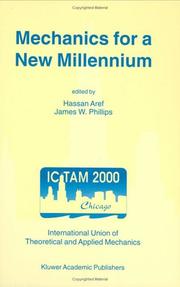
ISBN: 1280205229 9786610205226 0306469561 0792371569 9780792371564 Year: 2002 Publisher: Dordrecht : Springer Netherlands : Imprint: Springer,
Abstract | Keywords | Export | Availability | Bookmark
 Loading...
Loading...Choose an application
- Reference Manager
- EndNote
- RefWorks (Direct export to RefWorks)
The 20th International Congress of Theoretical and Applied Mech- ics, ICTAM 2000, took place August 27 – September 2, 2000, in the c- ference facilities of the Chicago Marriott Downtown on Michigan Avenue in Chicago, Illinois, USA. The Congress was invited by the US National Academy of Sciences on the recommendation of its National Comm- tee on Theoretical and Applied Mechanics. A consortium of university departments and programs acted as the local hosts. The undersigned served, respectively, as President and Secretary-General of the Congress. In this Proceedings volume we have attempted to capture the exci- ment of that memorable week. We have laid out the book so that it, roughly, tracks the events during the week of the Congress in much the order in which they occurred. We have given addresses and reports in context, although sometimes with embellishments to provide more data than could reasonably be presented orally. We have tried to reproduce essentials of the Opening and Closing ceremonies for the benefit of those who could not attend one or the other. We have tried to assemble an attractive volume that will have lasting value by adding an extensive name index and a briefer keyword index, and by exercising considerable care in the consistency of the layout of the full manuscripts. The international congresses of mechanics are major events of the field—we compare them to the Olympic Games in sports.
Mechanics, Analytic --- Mechanics, Applied --- Engineering. --- Mathematical models. --- Mechanics. --- Mechanical engineering. --- Civil engineering. --- Materials science. --- Mechanical Engineering. --- Civil Engineering. --- Characterization and Evaluation of Materials. --- Mathematical Modeling and Industrial Mathematics. --- Surfaces (Physics). --- Classical Mechanics. --- Models, Mathematical --- Simulation methods --- Material science --- Physical sciences --- Engineering --- Public works --- Classical mechanics --- Newtonian mechanics --- Physics --- Dynamics --- Quantum theory --- Engineering, Mechanical --- Machinery --- Steam engineering --- Mechanics, Analytic - Congresses. --- Mechanics, Applied - Congresses.
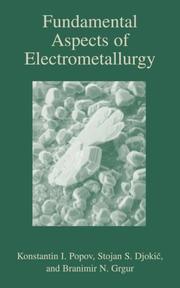
ISBN: 1280200529 9786610200528 0306475642 0306472694 Year: 2002 Publisher: New York, NY : Springer US : Imprint: Springer,
Abstract | Keywords | Export | Availability | Bookmark
 Loading...
Loading...Choose an application
- Reference Manager
- EndNote
- RefWorks (Direct export to RefWorks)
Electrometallurgy. --- Electrochemistry. --- Chemistry. --- Materials. --- Surfaces (Physics). --- Chemical engineering. --- Chemistry, Physical organic. --- Metallic Materials. --- Characterization and Evaluation of Materials. --- Industrial Chemistry/Chemical Engineering. --- Physical Chemistry. --- Metals. --- Materials science. --- Physical chemistry. --- Chemistry, Theoretical --- Physical chemistry --- Theoretical chemistry --- Chemistry --- Chemistry, Industrial --- Engineering, Chemical --- Industrial chemistry --- Engineering --- Chemistry, Technical --- Metallurgy --- Material science --- Physical sciences --- Metallic elements --- Chemical elements --- Ores --- Chemistry, Physical and theoretical --- Chemistry, Physical and theoretical.
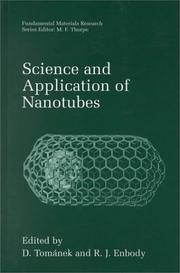
ISBN: 1591248612 0306463725 0306470985 Year: 2002 Publisher: New York ; Boston ; Dordrecht ; London ; Moscow : Kluwer Academic Publishers,
Abstract | Keywords | Export | Availability | Bookmark
 Loading...
Loading...Choose an application
- Reference Manager
- EndNote
- RefWorks (Direct export to RefWorks)
This series of books, which is published at the rate of about one per year, addresses fundamental problems in materials science. The contents cover a broad range of topics from small clusters of atoms to engineering materials and involve chemistry, physics, materials science, and engineering, with length scales ranging from Ångstroms up to millimeters. The emphasis is on basic science rather than on applications. Each book focuses on a single area of current interest and brings together leading experts to give an up-to-date discussion of their work and the work of others. Each article contains enough references that the interested reader can access the relevant literature. Thanks are given to the Center for Fundamental Materials Research at Michigan State University for supporting this series. M. F. Thorpe, Series Editor E-mail: thorpe@pa. msu. edu East Lansing, Michigan V PREFACE It is hard to believe that not quite ten years ago, namely in 1991, nanotubes of carbon were discovered by Sumio Iijima in deposits on the electrodes of the same carbon arc apparatus that was used to produce fullerenes such as the “buckyball”. Nanotubes of carbon or other materials, consisting ofhollow cylinders that are only a few nanometers in diameter, yet up to millimeters long, are amazing structures that self-assemble under extreme conditions. Their quasi-one-dimensional character and virtual absence of atomic defects give rise to a plethora of unusual phenomena.
Nanostructured materials --- Tubes --- Surfaces (Physics). --- Computer engineering. --- Chemistry. --- Characterization and Evaluation of Materials. --- Condensed Matter Physics. --- Electrical Engineering. --- Chemistry/Food Science, general. --- Materials science. --- Condensed matter. --- Electrical engineering. --- Physical sciences --- Electric engineering --- Engineering --- Condensed materials --- Condensed media --- Condensed phase --- Materials, Condensed --- Media, Condensed --- Phase, Condensed --- Liquids --- Matter --- Solids --- Material science
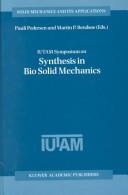
ISBN: 1280205180 9786610205189 0306469391 0792356152 Year: 2002 Publisher: Dordrecht : Springer Netherlands : Imprint: Springer,
Abstract | Keywords | Export | Availability | Bookmark
 Loading...
Loading...Choose an application
- Reference Manager
- EndNote
- RefWorks (Direct export to RefWorks)
This book contains the edited version of invited lectures presented at the IUTAM-Sym- sium Synthesis in Bio Solid Mechanics, held at Hotel Frederiksdal, Virum (Copenhagen), Denmark, May 24 to May 27, 1998. The symposium was attended by 48 scientist from 14 countries. Biomechanics has been a very active research area in the last 25 years and covers a very broad class of problems. The present symposium concentrated on the solid mechanics - main of biomechanics, where important problems of synthesis presently are an active and challenging part. Characteristics of biomechanical materials are not only the inhomogeneity and anisotropy, but also the capability to change in relation to actual use. These living materials call for new methods of analysis and also new methods for synthesis. By the synthesis in this context is meant design of implants or artificial control of material growth. Bone mechanics is closely related to recent work on analysis and design of microstructural anisotropic materials. Also, recent work in shape design can to some extent be useful in the more complicated problems of biomechanics. Here interface problems play an essential role. The symposium brought together scientists from mechanics, mathematics and medicine.
Bone remodeling --- Biomechanics --- Biotechnology. --- Human physiology. --- Materials. --- Surfaces (Physics). --- Mechanics. --- Biomedical engineering. --- Human Physiology. --- Materials Science, general. --- Characterization and Evaluation of Materials. --- Classical Mechanics. --- Biomedical Engineering and Bioengineering. --- Materials science. --- Clinical engineering --- Medical engineering --- Bioengineering --- Biophysics --- Engineering --- Medicine --- Classical mechanics --- Newtonian mechanics --- Physics --- Dynamics --- Quantum theory --- Material science --- Physical sciences --- Human biology --- Medical sciences --- Physiology --- Human body --- Chemical engineering --- Genetic engineering
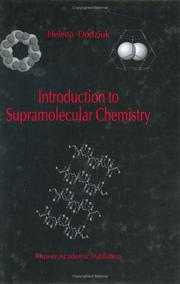
ISBN: 1280200758 9786610200757 0306475871 1402002149 Year: 2002 Publisher: Dordrecht : Springer Netherlands : Imprint: Springer,
Abstract | Keywords | Export | Availability | Bookmark
 Loading...
Loading...Choose an application
- Reference Manager
- EndNote
- RefWorks (Direct export to RefWorks)
A new rapidly progressing field on the crossroads among chemistry, biochemistry, physics and technology - supramolecular chemistry - has just emerged. You have to be involved, to know what's going on in this domain and to take part in the development. This book will show you in a condensed form exciting phenomena unthinkable within the realm of classical organic chemistry (for example, alkali metal anions or cyclobutadiene stable for month at room temperature) that not only provide the basis for revolutionizing numerous branches of industry but also improve our understanding of the functioning of living organisms and of the origin of life. Designing supramolecular systems with desired properties will among others make chemical industry cleaner and more safe, electronics smaller by developing devices composed of single molecule or molecular aggregate. It will also entirely change the way we use energy resources. In addition, it will also transform the pharmaceutical industry and medicine by developing new ways of drugs administration and new composite biocompatible materials which will serve as implants of new generation changing dentistry, surgery, and other branches of medicine. You cannot afford to stand apart. With its brief but comprehensive and vivid presentation including the latest development, Introduction to Supramolecular Chemistry is the best method to get into this domain. This book provides an excellent summary of information scattered across the literature. The brief but comprehensive coverage of the whole field including practically all important group of compounds forming aggregates (in particular crown ethers, cavitands, fullerenes, cyclodextrins and their complexes) provisioning full references for the discussed subjects make this book of value not only for Ph.D. students and non-specialists in this domain but also for those working in the field. The book has been found to be a particularly useful resource for students and more generally for those wanting to get the up-to-date concise account of this exciting field.
Supramolecular chemistry. --- Supramolecular electrochemistry. --- Chemistry, Physical organic. --- Surfaces (Physics). --- Analytical biochemistry. --- Chemistry. --- Physical Chemistry. --- Characterization and Evaluation of Materials. --- Analytical Chemistry. --- Chemistry/Food Science, general. --- Physical chemistry. --- Materials science. --- Analytical chemistry. --- Physical sciences --- Analysis, Chemical --- Analytic chemistry --- Chemical analysis --- Chemistry, Analytic --- Chemistry --- Material science --- Chemistry, Theoretical --- Physical chemistry --- Theoretical chemistry
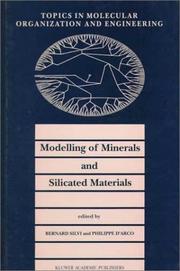
ISBN: 1280205237 9786610205233 0306469332 0792343336 Year: 2002 Publisher: New York : Kluwer Academic Publishers,
Abstract | Keywords | Export | Availability | Bookmark
 Loading...
Loading...Choose an application
- Reference Manager
- EndNote
- RefWorks (Direct export to RefWorks)
The modeling of minerals and silicated materials is a. difficult challenge faced by Solid StatePhysics, Quantum Chemistry and Molecular Dynamics communities. The difficulty of such a modeling is due to the wide diversity of elements, including heavy atoms,and types of bonding involved in such systems. Moreover, one has to consider infinite systems: either perfect cr- tals or glasses and melts. In the solid state a given chemical composition gives rise to numerous polymorphs, geometricallycloselyrelated. These polymorphs have very similar energies and related thermodynamical pr- erties which explain the complexity of their phase diagrams. The modeling of silicates and minerals covers a wide field of applications ranging from basic research to technology, from Solid State Physics to Earth and Planetary science. The use of modeling techniques yields information of different nature. In the case of chemical studies, we can mention inv- tigations on catalytic processes occurring on surfaces and in zeolite cages. These calculations find possible applications in chemical engineering, in particular in the oil industry.
Minerals --- Silicates --- Mathematical models. --- Chemistry, inorganic. --- Mineralogy. --- Surfaces (Physics). --- Inorganic Chemistry. --- Characterization and Evaluation of Materials. --- Condensed Matter Physics. --- Inorganic chemistry. --- Materials science. --- Condensed matter. --- Condensed materials --- Condensed media --- Condensed phase --- Materials, Condensed --- Media, Condensed --- Phase, Condensed --- Liquids --- Matter --- Solids --- Material science --- Physical sciences --- Physical geology --- Crystallography --- Inorganic chemistry --- Chemistry --- Inorganic compounds
| Listing 1 - 10 of 46 | << page >> |
Sort by
|

 Search
Search Feedback
Feedback About UniCat
About UniCat  Help
Help News
News